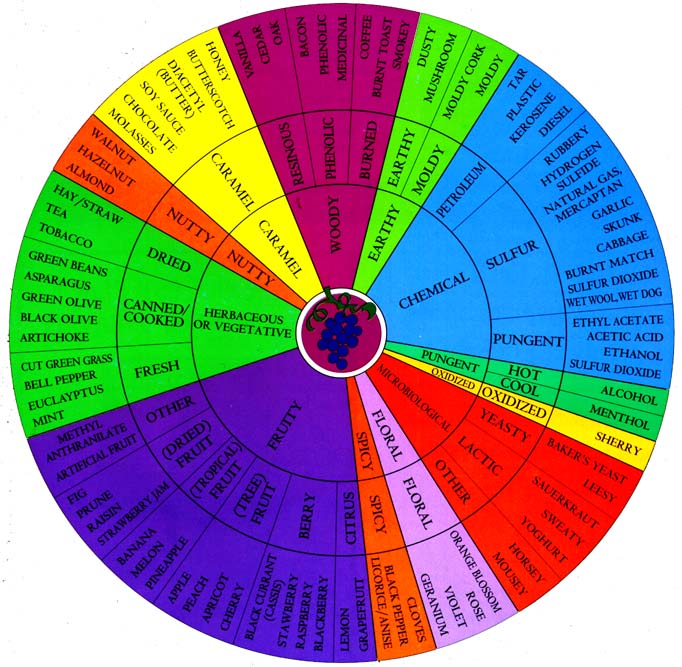The Davis Wine Aroma Wheel is the perfect way for wine lovers to get a look at the numerous fragrances and flavors found in most wines. Each of these unique fragrances found in wine, are due to the grapes being used in the production of the wine, coupled with the soils and terroir or soil the grapes were planted in and the choices made by the wine maker. The graphs and information found on the wine aroma wheel will help you identify what you are tasting and smelling. For tips on becoming a better wine taster: How to taste wine
The Davis Wine Aroma Wheel is divided into several sections to help you visualize the different flavors, scents and aromatic qualities found in most red and white wines, regardless of the grape variety. The same aromatic complexities and sensations pictured on the wine aroma wheel are found in red and white wines all over the world, from Bordeaux, to California and the Rhone Valley, as well as every other viticultural area.
In young wines, initially tasters will experience what is known as primary aromas. These early scents come predominantly from the fruits, which include notes of berries, grape, cherry, strawberry, boysenberry, cassis, blueberry, blackberry and black cherry in red wines. In white wines, the early aromatic qualities most often expressed range from citrus top apple, pear, pineapple or other tropical fruits. Young wines often offer coffee, vanilla or chocolate notes from the oak, as well as floral, stone, licorice and jammy scents.
However, not all scents in wine are positive. There are faults as well. The biggest fault in a wine takes place due to TCA, which causes a wine to smell like a wet dog, or old, wet newspapers. For Help with How to Recognize a Corked Wine and its Causes
With time and bottle age, wines develop secondary or tertiary qualities which add layers of depth and complexity a wines bouquet. Some of the more easily recognizable tertiary aromas include tobacco, truffle, earth, spice box, chocolate, smoke, crushed stone and cigar box. These secondary qualities are prized as only the worlds’ best wines are capable of aging and developing these additional layers of complexity.
To get an idea for how some of these words and terms found in the wine aroma wheel are used to describe wine, you can search through thousands of Wine Tasting Notes. To help you come up with the words and terms you feel comfortable with to allow you to discuss the wines that interest you, this is a very helpful link: ABC of Wine, A Glossary of Important Wine Terms
To read more about the most important grapes, including all the noble grape varieties used to produce red and white wine most often written about in The Wine Cellar Insider, please see: Guide to Wine Grapes
Wine Aroma Wheel copyright 2002 A.C. Noble
| Fruit Aromas | Citrus | Grapefruit |
| Lemon | ||
| Berry | Blackberry | |
| Raspberry – Red Raspberry and Black Raspberry | ||
| Strawberry | ||
| Black Currant (Cassis) | ||
| (Tree) Fruit | Cherry – Black Cherry and Red Cherry | |
| Apricot | ||
| Peach | ||
| Apple | ||
| (Tropical) Fruit | Pineapple | |
| Melon | ||
| Banana | ||
| (Dried) Fruit | Strawberry Jam | |
| Raisin | ||
| Prune | ||
| Fig | ||
| Other | Artificial Fruit | |
| Methyl Anthranilate | ||
| Spice Aromas | Spicy | Licorice/Anise |
| Black Pepper | ||
| Cloves | ||
| Floral Aromas | Floral | Geranium |
| Violet | ||
| Rose | ||
| Orange Blossom | ||
| Microbiological Scents | Yeasty | Leesy |
| (Often these are faults) | Baker’s Yeast | |
| Lactic | Yogurt | |
| Sweaty | ||
| Sauerkraut | ||
| Other | Mousy | |
| Horsey | ||
| Sherry Aromas | Oxidized | Oxidized |
| (Often these are faults) | ||
|
Pungent Aromas
(Often these are faults)
|
Cool | Menthol |
| Hot | Alcohol | |
| Chemical Smells | Pungent | Sulfur Dioxide |
| (Most are Serious Defects) | Ethanol | |
| Acetic Acid | ||
| Ethyl Acetate | ||
| Sulfur | Wet Wool, Wet Dog | |
| Sulfur Dioxide | ||
| Burnt Match | ||
| Cabbage | ||
| Skunk | ||
| Garlic | ||
| Natural Gas, Mercaptain | ||
| Hydrogen Sulfide | ||
| Rubbery | ||
| Petroleum | Diesel | |
| Kerosene | ||
| Plastic | ||
| Tar | ||
| Earthy Aromas | Moldy | Moldy Cork |
| Moldy | ||
| Earthy | Mushroom | |
| Dusty | ||
| Wood Aromas | Burned | Smoky |
| Burnt Toast | ||
| Coffee | ||
| Phenolic | Medicinal | |
| Phenolic | ||
| Bacon | ||
| Resinous | Oak | |
| Cedar | ||
| Vanilla | ||
| Caramel Aromas | Caramel | Honey |
| Butterscotch | ||
| Diacetyl (Butter) | ||
| Soy Sauce | ||
| Chocolate | ||
| Molasses | ||
| Nut Aromas | Nutty | Walnut |
| Hazelnut | ||
| Almond | ||
| Herbaceous or Vegetative Aromas |
Fresh | Cut Green Grass |
| Can be a fault | Bell Pepper | |
| Eucalyptus | ||
| Mint | ||
| Canned/Cooked | Green Beans | |
| Asparagus | ||
| Green Olive | ||
| Black Olive | ||
| Artichoke | ||
| Dried | Hay/Straw | |
| Tea | ||
| Tobacco | ||

